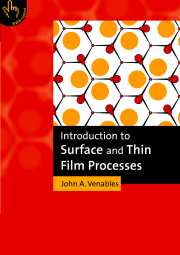Book contents
- Frontmatter
- Contents
- Preface
- Chapter 1 Introduction to surface processes
- Chapter 2 Surfaces in vacuum: ultra-high vacuum techniques and processes
- Chapter 3 Electron-based techniques for examining surface and thin film processes
- Chapter 4 Surface processes in adsorption
- Chapter 5 Surface processes in epitaxial growth
- Chapter 6 Electronic structure and emission processes at metallic surfaces
- Chapter 7 Semiconductor surfaces and interfaces
- Chapter 8 Surface processes in thin film devices
- Chapter 9 Postscript – where do we go from here?
- Appendix A Bibliography
- Appendix B List of acronyms
- Appendix C Units and conversion factors
- Appendix D Resources on the web or CD-ROM
- Appendix E Useful thermodynamic relationships
- Appendix F Conductances and pumping speeds, C and S
- Appendix G Materials for use in ultra-high vacuum
- Appendix H UHV component cleaning procedures
- Appendix J An outline of local density methods
- Appendix K An outline of tight binding models
- References
- Index
Appendix C - Units and conversion factors
Published online by Cambridge University Press: 06 July 2010
- Frontmatter
- Contents
- Preface
- Chapter 1 Introduction to surface processes
- Chapter 2 Surfaces in vacuum: ultra-high vacuum techniques and processes
- Chapter 3 Electron-based techniques for examining surface and thin film processes
- Chapter 4 Surface processes in adsorption
- Chapter 5 Surface processes in epitaxial growth
- Chapter 6 Electronic structure and emission processes at metallic surfaces
- Chapter 7 Semiconductor surfaces and interfaces
- Chapter 8 Surface processes in thin film devices
- Chapter 9 Postscript – where do we go from here?
- Appendix A Bibliography
- Appendix B List of acronyms
- Appendix C Units and conversion factors
- Appendix D Resources on the web or CD-ROM
- Appendix E Useful thermodynamic relationships
- Appendix F Conductances and pumping speeds, C and S
- Appendix G Materials for use in ultra-high vacuum
- Appendix H UHV component cleaning procedures
- Appendix J An outline of local density methods
- Appendix K An outline of tight binding models
- References
- Index
Summary
To convert a quantity expressed in the units listed in the first column to those listed in the third column, multiply by the number given in the second column. The SI unit is given in brackets for each quantity. The values with (±1σ) error bars are taken or deduced from the CODATA 1986 report (Cohen & Taylor 1987, 1998) as recommended by NIST in the USA and NPL in the UK. Note that it is not required to keep the full accuracy of these data to do the typical calculations encountered in this book, but it is helpful to have the extra decimal places were one to need them.
Mutiplication factors
The standard prefix is used for multiples and sub-multiples of units. These are shown in Table C1 below.
Information
- Type
- Chapter
- Information
- Introduction to Surface and Thin Film Processes , pp. 309 - 311Publisher: Cambridge University PressPrint publication year: 2000
